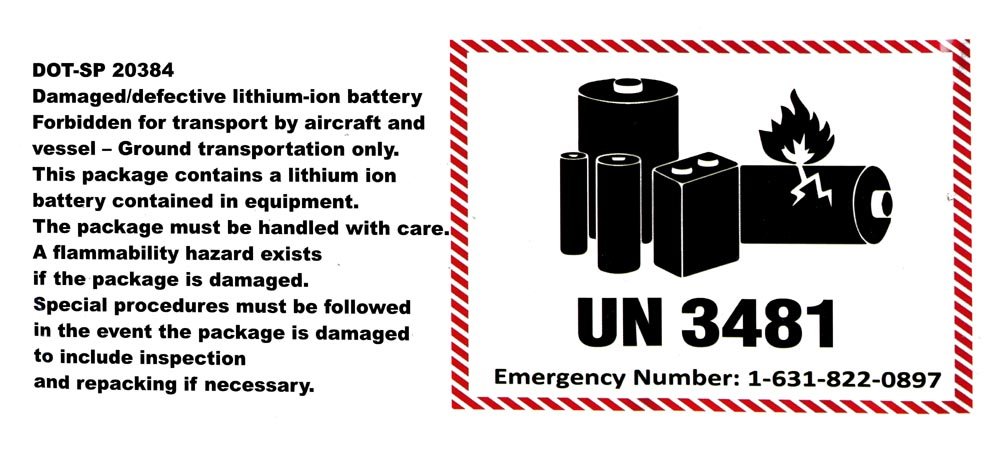In the situation of an accident, lithium-ion batteries have a greater energy density, especially the battery module, which can not be effectively controlled by conventional techniques when exposed to heat or continuous explosion of the battery, resulting in significant injuries or even death. In particular, burning or exploding lithium batteries on aircraft is considered extremely dangerous.
So, how did the lithium battery accident happen? Let's look at the features of the lithium battery to see.
Features of Lithium Battery
1 High Energy
If a lithium battery catches fire and erupts, the danger is considerable. Consider the 300Wh/kg square lithium-ion battery, which contains 1.08 × 10 6J of energy. A 1g TNT explosion can unleash. 4184J of energy, When the energy contained in a 1kg square lithium battery is converted, it was discovered that it equals roughly 258g TNT. This energy release in a confined area of a vehicle can cause significant harm.
2 Large volume
Lithium batteries have a high energy density, which is also reflected in their volume. The weight-to-volume ratio of lithium batteries is much higher than that of other types of batteries, such as lead-acid batteries. The larger the volume, the more difficult it is to control the fire.
3 Corrosive electrolyte
Lithium batteries use a corrosive electrolyte, usually a lithium salt in an organic solvent. When the electrolyte is exposed to air, it can ignite and burn. In addition, the electrolyte is also corrosive and can damage the skin.
4 Cell Consistency
All lithium batteries are made up of cells. When a cell is damaged, it can short circuit and heat up, causing the entire battery to overheat. This is why it is so important to keep lithium batteries in good condition and to avoid damage to the cells.
5 High voltage
The voltage of a lithium battery is generally between 3.6 and 4.2V. A lead-acid battery is only 2V. The higher the voltage, the greater the risk of fire and explosion.
How to safely ship the Lithium Battery

Now that we know the features of lithium batteries, let's look at how to ship lithium batteries safely.
1. Check the Battery
Before shipping, you need to check the battery to ensure that it is in good condition. Check for any damage to the cells, such as cracks or leaks. Also, make sure that the terminals are clean and free of corrosion.
2 Choose the Right Shipping Container
The shipping container you choose should be able to protect the battery from damage. It should also be able to contain any fire that may occur.
3. Pack the Battery Properly
When packing the battery, make sure that it is secure and cannot move around in the container. You should also put some padding around it to protect it from impact.
4. Label the Container
Be sure to label the container as containing a lithium battery. This will help ensure that it is handled properly during shipping.
5. Choose a Reputable Shipping Company
When shipping a lithium battery, it is important to choose a reputable shipping company. Make sure that they are familiar with the shipping requirements for these types of batteries.
By following these guidelines, you can help ensure that your lithium battery is shipped safely.
Some of the present transportation issues are a result of:

1 Less research on combustion mechanism and hazards
Lithium batteries have been researched and used commercially for over two decades, but their use in vehicles is relatively new. The mechanisms by which lithium batteries fail and release their energy are not well understood. As a result, the hazards associated with these failures are not well known.
However, research is mainly focused on the analysis of gas components after direct combustion, rather than the toxic gases produced by combustion. Few studies have been published about the dangers of toxic gases and dust, as well as diffusion mechanisms for them.
2 Ineffective security measures
There are no specific regulations governing the transportation of lithium batteries, so companies have been left to develop their own methods for doing so. As a result, the security measures in place are often ineffective.
For example, many companies do not properly test their shipping containers to ensure that they can withstand the forces of a fire or explosion. In addition, they often do not take into account the fact that lithium batteries can release their energy over a period of time, rather than all at once. This can lead to serious problems if the container is breached.
3 Transport test system is not perfect
The current transportation testing system is not perfect. For example, the UN 38.3 test only assesses the risk of a short circuit, not the other hazards associated with lithium batteries. In addition, the test does not take into account the fact that some battery types are more likely to fail than others.
As a result, many companies are not properly prepared to transport lithium batteries. This can lead to serious accidents and fires.
4 Lack of transportation safety evaluation ability
The majority of the third-party battery testing facilities aren't capable of testing lithium batteries. Because UN38.3 is a bit more demanding than UN38, only those with significantly higher energy lithium batteries are exempt from conducting UN38.3 series tests, which has caused laboratories to develop testing capabilities.
It is difficult to locate a suitable laboratory to conduct the tests and collect the necessary data in today's climate. The creation of proper test procedures and criteria, as well as evaluation standards, would be impossible without valid data.. lithium batteries are also tested, damaged, defective, recalled, and recycled in large amounts during this time.
UN38.3 series testing is required of these lithium batteries before they can be sent due to their poor suitability for qualifying tests under UN38.3. This vacuum has now arrived on the market and demands attention.
5 Insufficient risk prevention and control measures
Packaging that is appropriate can minimize the danger of hazardous products within a container and ensure safe transportation. Due to the high specific energy and huge size of lithium batteries, there is no appropriate packaging material or package form to minimize the possibility of shipment.
Internationally, the use of a fire hood or fireproof compartment within the compartment is still experimental. Similar items in China are still in the experimental stage. The use of these packaging techniques does not address the issue of lithium battery combustion, which generates large amounts of hazardous gases and dust.
6 Lack of efficient firefighting methods
In the event of a fire, it is difficult to extinguish a lithium battery fire with water. This is because the reaction between water and lithium can produce explosive hydrogen gas. In addition, the high temperatures produced by the fire can cause the release of toxic gases and dust.
The best way to extinguish a lithium battery fire is to remove the source of the ignition. This can be done by disconnecting the battery, removing it from the device, or placing it in a fire-resistant container. As a result, firefighters must take extra precautions when responding to fires.
Conclusion
Lithium batteries are a safe and efficient energy source. However, they can be dangerous if they are not used or transported properly. It is important to take the necessary precautions to ensure the safe use and transport of these batteries.

